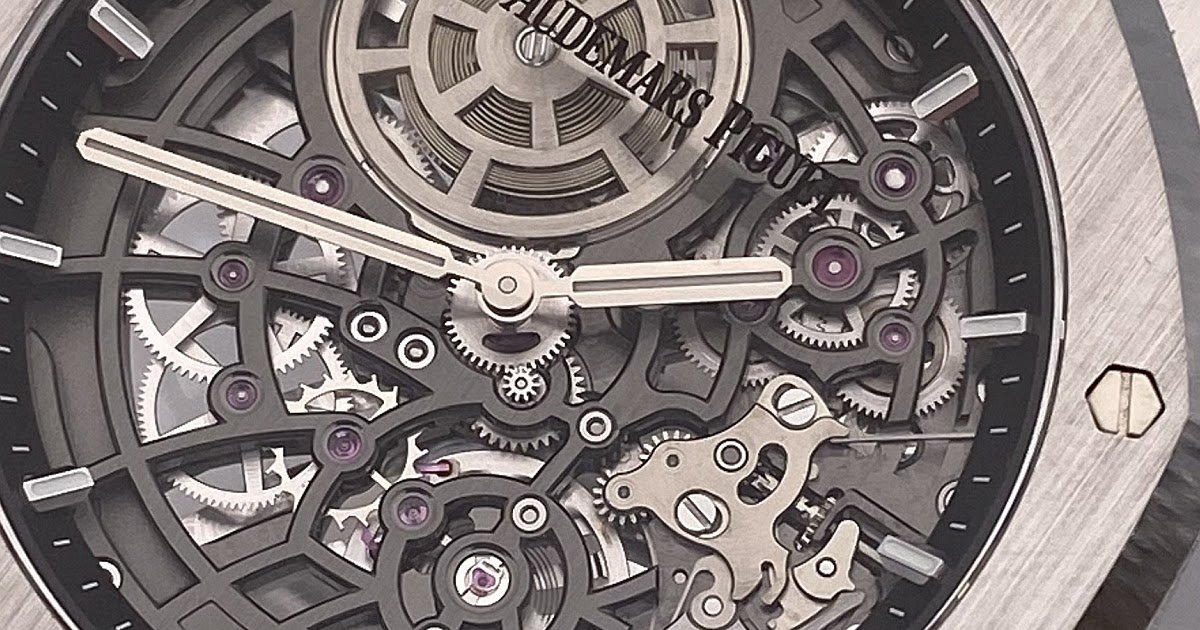The latest version of the Royal Oak Jumbo Skeleton was presented in 2022 in the context of the celebration of the 50th anniversary of the Royal Oak Jumbo. It was greeted with much excitement as it featured a skeletonized version of the Royal Oak’s brand new movement, the caliber 7121. Being a recently designed movement with improved performances and a completely different architecture from the historical caliber 2121, it was indeed interesting to discover Audemars Piguet’s interpretation of the skeletonization of this movement. Above all, there was no doubt that the result would be very different from the rendering of the references 15203 (in platinum) and 15204 (in pink) which featured a skeletonized version of the caliber 2121.
I recently had the opportunity to see this new Royal Oak Jumbo Skeleton. First of all, as I saw it two years after the anniversary celebration, it is important to specify that the initial reference 16204st (in steel) is no longer available and that only the gold versions are. So we had to get it right, but since the references 15203/15204 did not exist in steel, we did not need to be extra-lucid to imagine that the lifespan of the steel version would be very short. In any case, the fact of discovering it in white gold in this case did not spoil my pleasure, quite the contrary. I find this watch very beautiful and perfectly executed.
It first takes advantage of the fact that the actual diameter of the 7124 caliber (skeletonized version of the 7121) is larger than that of the 5122 caliber (skeletonized version of the 2121). The difference is notable (29.6mm vs. 28.4mm), especially since the 16204 does not have a date display, while the date window and disc occupied a significant space on the dial of the 15204.
In addition, the contemporary architecture of the 7124 movement leads to a skeleton structure distinct from that of the 5122 caliber. On the latter, the decorative approach is classic and not very airy. It should not be forgotten that the 2120/2121 calibers were developed in the late 60s and included many optimizations to obtain the thinnest automatic movement in the world, all with a decent power reserve (40 hours) and a rare frequency (2.75 Hz). The skeletonization highlights the impressive technical work carried out on these venerable calibers that are over 50 years old.
The objective behind the development of the 7121 movement and its skeletonized 7124 version was similar to the base: to equip a Jumbo, the automatic caliber must be as thin as possible. But the desire was also to improve technical performance. The 7121 caliber integrates a rapid date correction system, a 52-hour power reserve and a frequency of 4 Hz. It is part of this new generation of movements at Audemars Piguet which takes advantage of technical advances to obtain regular winding and stable behavior. I personally used this movement for many weeks and I was able to appreciate its regularity of operation, its precision. It is a well-born movement and this is reflected in the skeletonized caliber 7124. The latter gains in power reserve (it therefore increases to 57 hours) due to the removal of the date display.
Regarding the aesthetic approach, it is in my opinion ideal. It embodies a sort of balance between classicism and modernity. The cutting of the bridges is part of a continuity of the watchmaking tradition even if the result is more airy than with the caliber 5122. What makes the difference is that the whole breathes and occupies the dial better due to the removal of the date disc. In addition, the anthracite finish is much more contemporary and creates a better contrast with the moving elements such as the gears and the winding and time-setting mechanism. The barrel is here in the foreground on the dial side and its circular skeleton pattern is very pleasant (it is often the weak point of a skeleton) and similar to that of the balance bridge. The regulating organ is very visible as a whole, whether it is the oscillations of the balance wheel or the escape wheel. The back of the movement is consistent with the aesthetic rendering on the dial side. The hollowed-out oscillating weight allows one to appreciate the quality of the work and the barrel bridge is also nicely executed.
So I am enchanted by this new Royal-Oak Jumbo Skeleton. While retaining the original size of the Jumbo (a diameter of 39mm and a thickness of 8.1mm), it manages to reinterpret with great elegance and dynamism the skeletonized approach of the previous models based on the caliber 5122. In fact, it constitutes a sort of convergence point of Audemars Piguet’s achievements in recent years. It has the contemporary style of the Double-Balance, the performance linked to the new caliber 7124 and the natural finesse and classicism of the Jumbo. The way in which the skeletonization occupies the dial and highlights the functioning of the movement gives it an undeniable power of seduction thanks to a more harmonious visual rendering. The downside is that it now only exists in gold and this is reflected in the label. I don’t have the exact price in mind, but when the rose gold version was presented in 2022, its price was over 110,000 euros. This gives an idea of what the price of the reference 16204 in white gold must be today (with a few percent more). In any case, I consider this watch remarkable.
Most:
+ the improved performance of the 7124 caliber
+ removal of the date display
+ the best occupation of the dial
+ the enhancement of the regulating organ
The lessers:
– I could mention the price but isn’t it logical after all given the demand for such a model and its second-hand rating?
